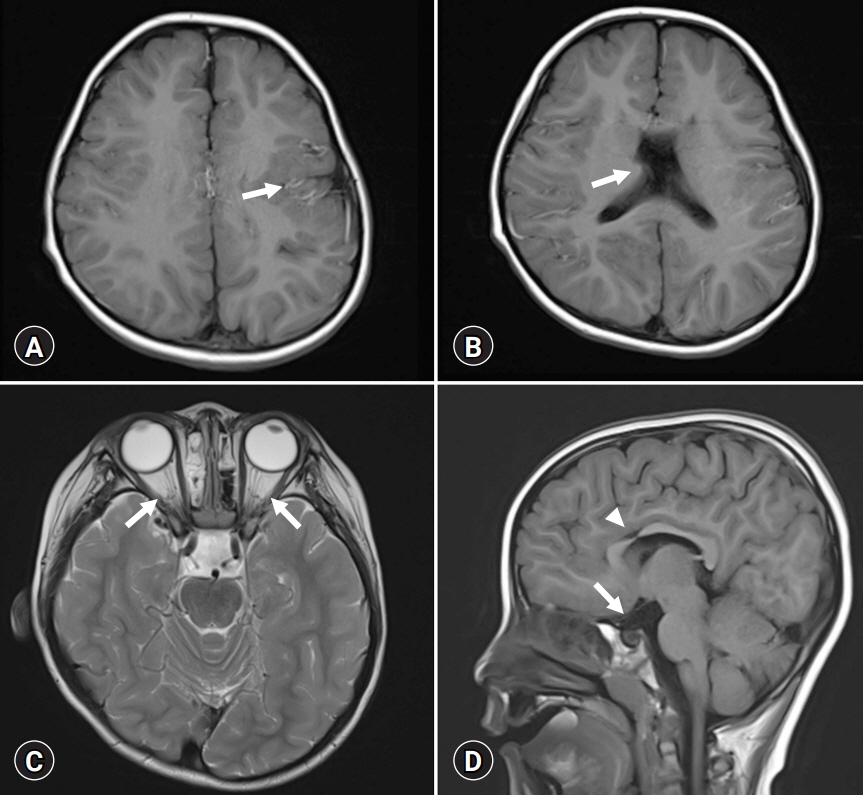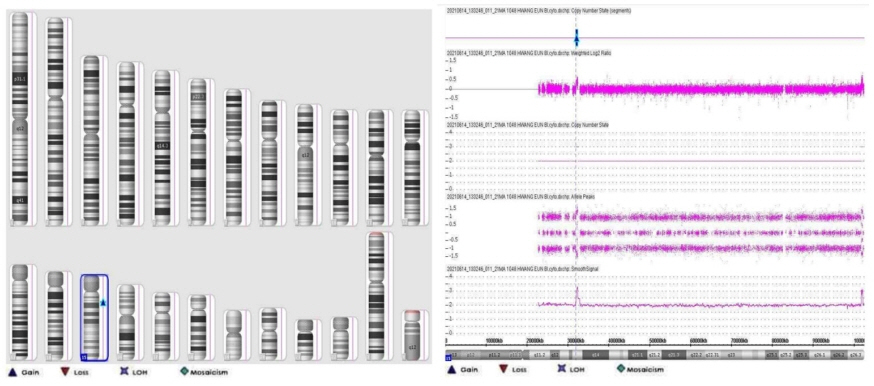J Yeungnam Med Sci.
2023 Oct;40(4):419-422. 10.12701/jyms.2022.00493.
Septo-optic dysplasia associated with chromosome 15q13.3 duplication: a case report
- Affiliations
-
- 1Department of Rehabilitation Medicine, DMC Bundang Jesaeng Hospital, Seoungnam, Korea
- 2Department of Physical Medicine and Rehabilitation, Ulsan University Hospital, University of Ulsan College of Medicine, Ulsan, Korea
- KMID: 2547366
- DOI: http://doi.org/10.12701/jyms.2022.00493
Abstract
- Septo-optic dysplasia (SOD) is a rare congenital anomaly that is clinically defined by developmental delay and characteristic brain magnetic resonance imaging findings, including optic nerve hypoplasia, pituitary hormone abnormalities, and midline brain defects. The occurrence of SOD is generally sporadic; however, it can be inherited rarely. Although an association with HESX1, SOX2, and SOX3 mutations has been identified, the detailed etiology is multifactorial and unclear. Here, we present the case of a 7-year-old girl who was clinically diagnosed with SOD and 15q13.3 duplication. Patients with duplication at chromosome 15q13.3 were reported to be diagnosed with autism spectrum disorder, epilepsy, and schizophrenia in previous studies. The relationship between SOD and the microduplication of 15q13.3 has not yet been explored. In this study, we suggest that there may be an association between chromosome 15q13.3 microduplication and SOD.
Figure
Reference
-
References
1. Ward DJ, Connolly DJ, Griffiths PD. Review of the MRI brain findings of septo-optic dysplasia. Clin Radiol. 2021; 76:160. e1-14.
Article2. Webb EA, Dattani MT. Septo-optic dysplasia. Eur J Hum Genet. 2010; 18:393–7.
Article3. Kelberman D, Dattani MT. Genetics of septo-optic dysplasia. Pituitary. 2007; 10:393–407.
Article4. Miller DT, Shen Y, Weiss LA, Korn J, Anselm I, Bridgemohan C, et al. Microdeletion/duplication at 15q13.2q13.3 among individuals with features of autism and other neuropsychiatric disorders. J Med Genet. 2009; 46:242–8.
Article5. Lowther C, Costain G, Stavropoulos DJ, Melvin R, Silversides CK, Andrade DM, et al. Delineating the 15q13.3 microdeletion phenotype: a case series and comprehensive review of the literature. Genet Med. 2015; 17:149–57.
Article6. Sinkus ML, Graw S, Freedman R, Ross RG, Lester HA, Leonard S. The human CHRNA7 and CHRFAM7A genes: a review of the genetics, regulation, and function. Neuropharmacology. 2015; 96(Pt B):274–88.
Article7. Albuquerque EX, Pereira EF, Alkondon M, Rogers SW. Mammalian nicotinic acetylcholine receptors: from structure to function. Physiol Rev. 2009; 89:73–120.
Article8. Ross RG, Stevens KE, Proctor WR, Leonard S, Kisley MA, Hunter SK, et al. Research review: cholinergic mechanisms, early brain development, and risk for schizophrenia. J Child Psychol Psychiatry. 2010; 51:535–49.
Article9. Szafranski P, Schaaf CP, Person RE, Gibson IB, Xia Z, Mahadevan S, et al. Structures and molecular mechanisms for common 15q13.3 microduplications involving CHRNA7: benign or pathological? Hum Mutat. 2010; 31:840–50.
Article10. Xie Y. Is chromosome 15q13.3 duplication involving CHRNA7 associated with oral clefts? Child Neurol Open. 2015; 2:2329048X15618918.
Article11. Dattani MT, Martinez-Barbera JP, Thomas PQ, Brickman JM, Gupta R, Mårtensson IL, et al. Mutations in the homeobox gene HESX1/Hesx1 associated with septo-optic dysplasia in human and mouse. Nat Genet. 1998; 19:125–33.
Article12. Hagstrom SA, Pauer GJ, Reid J, Simpson E, Crowe S, Maumenee IH, et al. SOX2 mutation causes anophthalmia, hearing loss, and brain anomalies. Am J Med Genet A. 2005; 138A:95–8.



